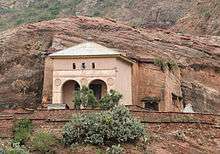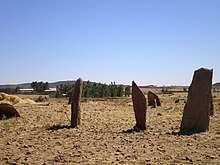Gudit
Gudit (Ge'ez: ጉዲት) was a Jewish queen from the Jewish Kingdom of Semien(flourished ca. 960) who, according to local legend, laid waste to Axum and its countryside, destroyed churches and monuments, and attempted to exterminate the members of the ruling dynasty of the Kingdom of Aksum.[1][2] Her deeds are recorded in the oral tradition and mentioned incidentally in various historical accounts.


Information about Gudit is contradictory and incomplete. Paul B. Henze wrote, "She is said to have killed the emperor, ascended the throne herself, and reigned for 40 years. Accounts of her violent misdeeds are still related among peasants in the north Ethiopian countryside."[3] Henze continues in a footnote:
On my first visit to the rock church of Abreha and Atsbeha in eastern Tigray in 1970, I noticed that its intricately carved ceiling was blackened by soot. The priest explained it as the work of Gudit, who had piled the church full of hay and set it ablaze nine centuries before.[4]
There is a tradition that Gudit sacked and burned Debre Damo, an amba which at the time was a treasury and a prison for the male relatives of the king; this may be an echo of the later capture and sack of Amba Geshen by Ahmad ibn Ibrahim al-Ghazi.[5] Gudit is known as ʿEsato in Amharic, which means "fire".[1] Gudit is so related to the destruction of the Axumite Empire, that the name ጉዲት in Amharic is commonly translated as "destruction".[6]
However, James Bruce presented a tradition that Dil Na'od was overthrown by Gudit, and that Mara Takla Haymanot (whom Bruce calls "Takla Haymanot") was a cousin of Gudit who succeeded her after several of her own family.[7]
In oral tradition, Gudit is sometimes conflated with the 16th-century Muslim queen Ga'ewa of Tigray.[8]
Ethnicity
Carlo Conti Rossini first proposed that the account of this warrior queen in the History of the Patriarchs of Alexandria, where she was described as Bani al-Hamwiyah, ought to be read as Bani al-Damutah, and argued that she was ruler of the once-powerful kingdom of Damot, and that she was related to one of the indigenous Sidama people of southern Ethiopia.[9]
Modern historian Enrico Cerulli discovered Arabic documents that mention a Muslim queen named Badit daughter of Maya in the tenth century who reigned under the Makhzumi dynasty.[10][11] According to historian Tekeste Negash, Gudit was a Cushitic queen based at Lake Hayq in Wollo Province of Ethiopia. He further explains that there may have been a regional power struggle between Axum and this queen of Wollo whom had ties to Yemeni traders through the port of Zeila.[12] Somali folklore also mentions a Harla queen Arawelo, who governed from Zeila into much of the interior of the Eastern Africa.[13]
In more recent perspectives on the issue of the ethnicity of Gudit, there has been less certainty on to her actual identity and yet more certainty on the unlikelihood of her being of Judaic belief or associated with the Beta Israel. To quote from Kaplan (1992):[14]
Despite the Judith legend's popularity and its prominent position in the traditions of both Jews and Christians to this day, there appears to be several good reasons for rejecting the depiction of the tenth century queen of the Bani al-Hamwiyah as a Falasha. Although some Ethiopic sources do portray Yodit as a Jewess, these generally identify her as a convert rather than the product of a well entrenched indigenous religious community. The material recorded by Bruce, which contains the earliest complete account of the legend, must be considered suspect on several grounds... The suggestion that the Falasha queen Yodit, putative conqueror of Aksum, is in fact the pagan queen of the Sidama, vanquisher of the haḍani is not as startling as it might appear at first glance. By transforming the queen from a pagan to a Jewess and her primary area of activity from the south of Aksum, Christian tradition neatly places her within the primary categories of Ethiopian political-religious discourse. On some levels, the Judith traditions can be said to mirror the themes of the Kebra Nagast. Both the Queen of Sheba and Judith are depicted as converts to Judaism.
Historical evidence
It was during the office of Pope Philotheos of Alexandria when Gudit started her revolt, near the end of the reign of the king who had deposed the Abuna Petros. As Taddesse Tamrat explains, at the time "his own death in the conflict, and the military reverses of the kingdom were taken as divine retribution for the sufferings of Abuna Petros."[15]
This chronological synchronicity with the tenure of Patriarch Philotheos, and the intervention of king Georgios II of Makuria, provides us a date of ca. 960 for Gudit. A contemporary Arab historian, Ibn Hawqal, provides this account:
The country of the habasha has been ruled by a woman for many years now: she has killed the king of the habasha who was called Haḍani [from Ge'ez haṣ́ani, modern aṣ́e or atse]. Until today she rules with complete independence in her own country and the frontier areas of the country of the Haḍani, in the southern part of [the country of] the habashi.[16]
Another historian mentions that the king of Yemen sent a zebra to the ruler of Iraq in 969/970, which he had received as a gift from the Queen of al-Habasha.[17]
Legacy
Gudit (also known as Yodit) featured in the Age of Empires II: HD Edition: The African Kingdoms. The campaign is based on a tradition that she was a ruler who was exiled, where she married a Syrian Jew then returned to Aksum to restore her throne.[2]
See also
- Arawelo, a queen of the Somali people
- Furra, a queen of the Sidama people
References
- "Gudit". The Dictionary of Ethiopian Biography. Vol. 1 'From Early Times to the End of the Zagwé Dynasty c. 1270 A.D.'. 1975.
- Andersen, Knud Tage (2000). "The Queen of the Habasha in Ethiopian History, Tradition and Chronology". Bulletin of the School of Oriental and African Studies. 63 (1): 31–63. JSTOR 1559587.
- Henze, Paul B. (2000). Layers of Time, A History of Ethiopia. New York: Palgrave. p. 48. ISBN 1-4039-6743-1.CS1 maint: ref=harv (link)
- Henze (2000, p. 48 n. 14). His visit among others to various churches in Ethiopia can be read here Archived 2006-06-28 at the Wayback Machine.
- Recorded by Pakenham, Thomas (1959). The Mountains of Rasselas. New York: Reynal. p. 79. OCLC 967453.
- Ethiopian Jewish Women. Jewish Women's Archive
- Bruce. Travels to Discover the Source of the Nile. vol. 2 (1805 ed.). pp. 451–453.
- Yohannes Gebre Selassie; Iwona Gajda; Berhe Hiluf (2009), "Pre-Aksumite Inscriptions from Mäqabǝr Ga'ǝwa (Tigrai, Ethiopia)", Annales d'Éthiopie, 24: 33–48, doi:10.3406/ethio.2009.1386.
- Conti Rossini's argument is taken from Taddesse Tamrat's summary in Church and State in Ethiopia, 1270–1527. Oxford: Clarendon Press. 1972. p. 39. ISBN 0-19-821671-8.
- Fage, John; Oliver, Roland (1977). The Cambridge History of Africa. Cambridge University Press. p. 106. ISBN 978-0-521-20981-6.
- "Gudit fl. 10th century Orthodox Ethiopia". Dictionary of African Christian Biography. Archived from the original on 2012-02-12. Retrieved 3 July 2017.
- Negash, Tekeste (2006). "The Zagwe Period and the Zenith of Urban Culture in Ethiopia, Ca. 930-1270 Ad". Africa: Rivista trimestrale di studi e documentazione dell'Istituto italiano per l'Africa e l'Oriente. 1 (61): 123–124. JSTOR 40761842.
- Rayne, Henry (October 1938). "QUEEN ARAWEILO". Blackwoods Magazine. 238: 568–578. Archived from the original on 27 June 2001. Retrieved 20 June 2017.CS1 maint: BOT: original-url status unknown (link)
- Kaplan, Steven (1992). The Beta Israel (Falasha) in Ethiopia: From Earliest Times to the Twentieth Century. New York University Press. pp. 128–129. ISBN 0-8147-4625-X.
- Taddesse Tamrat, Church and State, pp. 40f. Although Taddesse Tamrat states that the name of this king is not known, E.A. Wallis Budge in his account of the tenure of Abuna Petros (A History of Ethiopia: Nubia and Abyssinia, 1928 [Oosterhout, the Netherlands: Anthropological Publications, 1970], p.276) calls him Degna Djan, who reigned perhaps as late as ca. 1100; this would conflict with Conti Rossi's chronology.
- Quoted in Taddesse Tamrat, Church and State p. 39. Habasha is the Arabic form of Abyssinia, i.e. Ethiopia.
- Munro-Hay, Stuart C. (1991). Aksum, an African Civilization of Late Antiquity. Edinburgh: University Press. p. 101. ISBN 0-7486-0106-6.